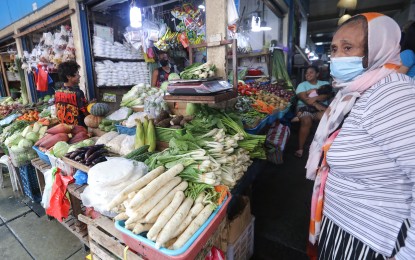
HIGHER INFLATION. Headline inflation further picks up to more than 6 percent in September. With elevation still outside the government's target, the National Economic and Development Authority on Thursday (Oct. 5, 2023) vowed that the government will continue to support vulnerable sectors. (PNA file photo)
MANILA – Headline inflation settled at 6.1 percent in September this year, higher than the 5.3 percent recorded in August, Philippine Statistics Authority (PSA) Undersecretary and National Statistician Dennis Mapa said on Thursday.
In a briefing, Mapa said inflation in September last year was at 6.9 percent.
Core inflation, which excludes volatile oil and food items, however, was down to 5.9 percent from 6.1 percent in August.
Mapa said the higher headline inflation rate during the month was primarily brought about by the higher year-on-year increase in the heavily-weighted food and non-alcoholic beverages at 9.7 percent from 8.1 percent in the previous month.
The main contributor to the higher inflation of food and non-alcoholic beverages was the faster increase in the prices of cereal and cereal products with an inflation of 14.1 percent from 8.3 percent in August and meat at 1.3 percent from -0.1 percent the previous month.
For rice alone, inflation went up to 17.9 percent from 8.7 percent in August.
Mapa said transport, with an inflation rate of 1.2 percent from 0.2 percent in the previous month, also contributed to the uptrend of the headline inflation.
Year-to-date, headline inflation settled at 6.6 percent which is still outside the central bank's 2 to 4 percent target.
Inflation in the National Capital Region (NCR) meanwhile also went up to 6.1 percent from 5.9 percent the previous month.
For areas outside NCR, inflation increased to 6.0 percent from 5.2 percent.
For the bottom 30 percent income households, inflation picked up to 6.9 percent from 5.6 percent in August.
In a separate statement on Thursday, the National Economic and Development Authority (NEDA) assured that the government will continue to provide support to the most vulnerable sectors while implementing necessary measures to respond to rising prices.
“The government is committed to providing targeted assistance to affected vulnerable segments of the population while food prices remain elevated,” NEDA Secretary Arsenio Balisacan said.
Balisacan said the government, through the Inter-Agency Committee on Inflation and Market Outlook (IAC-IMO), is proactively monitoring the demand-and-supply situation, particularly of key commodities, to give President Ferdinand R. Marcos Jr. and his Cabinet appropriate and timely policy recommendations.
“In line with this, we are closely monitoring both local and global markets in terms of price movement, as they may be affected by the availability of supply or disruptions in the supply chain,” he said.
During the last IAC-IMO meeting on Oct. 3, 2023, the committee recommended extending the lower Most Favored Nation (MFN) tariff rate on rice under Executive Order (EO) 10.
“To address the increasing price of rice and ensure enough supply through timely and adequate importation, the IAC-IMO recommends extending the lower MFN tariff rate on rice until December 2024, but subject to review in July 2024. This policy response must be complemented by efforts to improve the predictability and transparency of issuing the Sanitary and Phytosanitary Import Clearance for rice and all commodities,” Balisacan said.
To help cushion the impact of elevated inflation and address food poverty, the Department of Social Welfare and Development (DSWD) recently launched the digital Food Stamp Program.
The program provides PHP3,000 worth of monthly meal augmentation.
The DSWD will also provide a PHP10,000 cash subsidy to 78,000 farmers listed in the Pantawid Pamilyang Pilipino Program (4Ps).
Rice farmers are also set to get PHP5,000 as financial assistance to help sustain their productivity amid the increasing cost of production.
The Land Transportation Franchising and Regulatory Board also provided fuel subsidies to 74,089 public utility vehicles.
The National Food Authority Council also increased the buying price of dry palay to PHP23 from PHP19. The buying price of wet palay was also hiked to PHP19 from PHP16.
President Marcos also issued EO 41 which prohibits the collection of pass-through fees on national roads and urges local government units to suspend the collection of fees from vehicles transporting goods.
Balisacan said the global price of rice continues to rise due to the impacts of El Niño and rice export bans among key rice-exporting countries, resulting in a need to have a more robust response to stabilize local prices and revisit the proposal to temporarily lower tariffs on rice, regardless of origin.
“As we implement short-term measures to ease the negative effects of inflation, it is imperative that we also address our long-term food supply issues by providing support for our local farmers to boost their productivity and resilience. These include investing in irrigation, modern high-yielding varieties, pest control, and logistics,” he said. (PNA)
